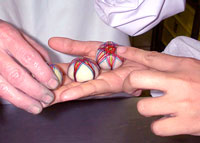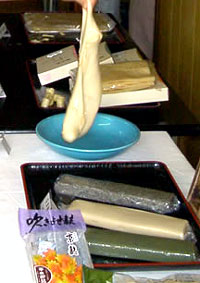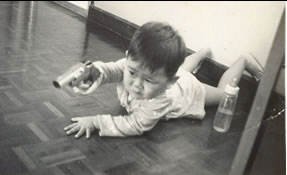 |
 |
||
 |
|||
Meet
the Kyoto 2001
June 28-29, 2001
Kyoto Prefectural International Center regularly organizes study programs, trips as well as home stay program to introduce various traditional Kyoto cultures to foreigners. The recent trip, called “Meet the Kyoto 2001” was to introduce Kyoto food material “Kyo-fu 京麩and Kyo-yuba京湯葉” and traditional Kyoto cuisine. The program divided into two days. The first day is to visit Fu and Yuba factory of Hanbeifu 半兵衛麩Co., Ltd. The second day, participants are invited to old restaurant Mangemero 萬亀楼which history traced back to old imperial era.
According to the pamphlet of the program, with thousands years history, character of Kyoto cuisine can be characterized as “continual striving for perfection”. Vegetable and soybean products are main ingredients of Kyoto food. Influenced by Zen Buddhist, the original taste is only slightly adjusted, leaves the food in subtle flavor.
Food Material of Kyoto Kyo-fu and Kyo-yuba
June 28, 2001
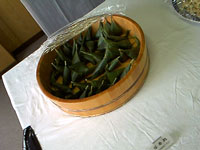
|
Fu and Yuba are a kind of vegetarian food. Fu is made from wheat while yuba is made from soy bean. We can find fu in our daily dish such as in miso soup, even in instant one, there is dry fu inside. Originally, fu and yuba were prepared and eaten in Buddhist temples as vegetarian food for monks in China. According to Buddhist rules, killing is prohibited so strictly follow, food must contain no meat. Fu and yuba therefore give vegetable protein substituted for animal protein in monks’ vegetarian food. When Japan imported Buddhism from China, fu and yuba were brought along as religious dish and were cooked only in Buddhist temples. There are two reasons why Kyoto becomes famous for fu and yuba. One is that Kyoto is center for Buddhism where thousands of temples located. Secondly, Kyoto water is famous for its purity and thus lends good taste for fu and yuba, both of which need lots of water in making. To make fu, one has to grind wheat around an hour until it becomes flour. Add water then pour white water off, leave only sticky mochi-like glutin. This sticky glutin is called nama-fu 生麩 which can also be cooked in various ways, boiled, grilled, fried etc. In China or Thailand, it can be found in normal vegetarian food. Another form of fu is yaki-fu焼き麩 which is the above nama-fu grilled until it becomes dry in form of long stick. This dry fu lasts for six months and normally put in soup. Yuba is made from soy bean. First, beans are left in water until they become soft. Then, boil and mash. Separate the bean-milk 豆乳 off and boiled the milk again. Take the film-like top layer to dry it. This film-like layer is yuba. Although fu and yuba can be found in daily life, in Buddhist temples, they are served in the special vegetarian dish called Shojinryouri 精進料理. This is not simply a dish without meat, but a dish in which composed of three fives, i.e. 1. Five colors五色:red 赤 (ex. carrot)、yellow黄 (ex. pumpkin, beans, sweet potato)、white 白 (ex. rice, radish)、black黒 (ex. shitake mushroom, konbu), green青 (ex. normal green leaves vegetable) 2. Five tastes五味:sweet, sour, bitter, salty and hot/spicy 3. Five way of cooking五法:fresh/raw, grill, steam, boil and fry. Furthermore, to appreciate Kyoto food is not simply enjoy the taste but also to think of food from its origin, of people who involve in preparing. Four thai are invited to join this program: Leng, Num, 1 and me. There are around forty people in the whole group, coming from all parts of the world. The study tour took place in the office of Hanbeifu. I don’t think it opens for all visitors so we got privilege to be here. After listening an interesting lecture “ Food Material of Kyoto” by the company president Mr. Tatsuji TAMAOKI 玉置 辰次氏, participants are separated into small groups of 7 to experience how to make fu and yuba. All of us except Num went to fu factory and made fu mochi. Although it looked so simple, we found it very difficult to make the shape of mochi neat and nice (to eat). We spread nama-fu onto our palm and put a cube of mash red bean. Then, fold fu to cover bean. Put this ball into boiled water for five minutes and leave in cold water for a while. Then, we wrap this ball by bamboo leave and it is ready to eat. However, since none of us is professional, the finished mochi was so ugly and although the company allowed us to take them home, not so many did so….maybe the rest would have been gone to the bin. After we came back from visiting the factory, we could taste other products of HANBEIFU. All were delicious and no surprise that they were taken home by everyone.
|
|
Further information: Hanbeifu Co.,Ltd. East office Goryo-cho 48, Nishihichijo, Shimogyou-ku, Kyoto 600-8893 Phone: 075-312-0008, 0120-49-0008 URL: www.hanbey.co.jp The company also operates a restaurant to introduce fu and yuba near Gojo bridge, next to its head office.
|
Kyoto Cuisine
Ikamaryu-Shikibocho and Yusoku ryouri (cuisine of the
Court)
June 29, 2001
In the second day of the program, we were invited to traditional Kyoto restaurant hidden in small road next to Horikawa. The old wooden gate led us into old Japanese house. First, the owner’s son performed Ikamaryu-shikibocho 生間流式包丁披露, the cutting fish ceremony, the art equally sophisticated as Tea ceremony and Ikebana. Fish was sliced and arranged into five parts, symbolized life in the sea. (you needs lots of imagination to understand, though.)
After that, Mr.Shigeyoshi Konichi 小西 重義氏, the president of Mangamero, gave lecture on Kyoto Cuisine. He showed old role of court food and shogun banquet food served in old days by his family. Honestly speaking, I didn’t really understand the lecture today since he spoke so fast and left no room for translation. Anyhow, the most impressive experience is that we were served the food by this restaurant! I didn’t know the name of the dish nor the style it was served, but I did enjoy it a lotJ yummy yummy.
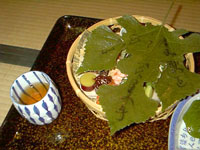 |
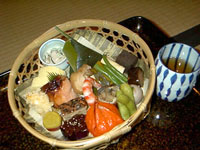 |
|
Further information: Mangamero restaurant Demizuagaru, Inokuma, Kamigyou-ku, Kyoto Phone: 075-441-5020
|
Sponsored by Kyoto Prefectural International Center
Phone: 075-342-5001
Fax: 075-342-5050

